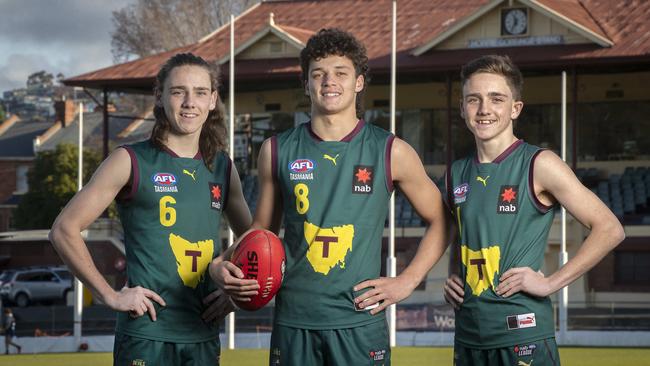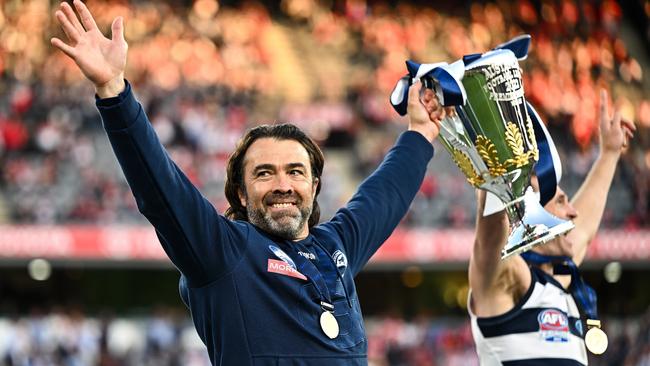AFL 2023: Tasmania finally gets a team, now it has 1784 days to get it right
There is no time to waste getting Tasmania’s AFL club ready for its first game in 2028. Here are the key positions that must be filled and the leading candidates.

When outgoing AFL chief executive Gillon McLachlan and Tasmanian premier Jeremy Rockliff ran through a banner with dozens of local kids to officially launch Tasmania’s stand-alone 19th team on Wednesday, it was roughly T-Minus 1784 days to a possible round 1, 2028 lift-off.
For a footy state that has waited the best part of four decades to join the national competition, this was a triumphant moment for the true believers.
But the reality behind the obvious excitement and expectation is that there is barely a moment to waste. It’s time to get to work.
The difficult births of the AFL’s two most recent franchises – Gold Coast and Greater Western Sydney, in particular the Suns – and the mistakes made setting those clubs up can provide McLachlan and his replacement Andrew Dillon with a better road map to a more sustainable and successful operation.
It won’t be easy. There will be hurdles and frustrations, but, unlike the other two ventures, this club will quite literally be built from the ground up – stadium and all – in a football heartland.
McLachlan strode into Tullamarine Airport just after 8am on Wednesday with the look of a man who had finally nutted out the deal that will stand as part of his ongoing legacy.
As he boarded Virgin Flight 1316 the AFL boss was in a jovial mood, joking that he hoped the zeros had been right in the deal that saw the Federal Government provide the last linchpin of a $240 million commitment to the building of a new stadium at Macquarie Point.
Then he added with a smile, that he was sure the figures were right.

On the flight with him was Andrew Dillon, who was this week announced as McLachlan’s successor, AFL executive Travis Auld, who missed out on the top gig, AFL Commissioner Paul Bassat and Richmond veteran Jack Riewoldt, whose Tassie heritage and belief in a stand-alone team added voice to the campaign for team from his home state.
As he entered the plane, Riewoldt carried the banner that McLachlan and Rockliff were meant to run through in a small white parcel kept for safekeeping in the overhead luggage compartment.
Fittingly, some Tasmanian wood was added to make the banner complete on arrival in Hobart – a sign that a collegiate approach from the island and the mainland is required.
The plane flight that would change the course of footy in Tassie took off 20 minutes later, but when you have been waiting as long as the state has, what’s a few extra minutes?
Gill had an appointment scheduled with Rockliff in the Premier’s office where some final details, and some paperwork, had to be attended to.
The launch venue of North Hobart Oval could hardly have been more appropriate. One of the great moments in Tasmanian football took place on the ground when a local-bred team composed mostly of AFL players defeated Victoria in a state-of-origin game in 1990.
Back then, one of the AFL executives Alan Schwab predicted Tasmania could be in the national competition by 1995. It never happened, and neither did other proposed bids.

This has been a long and sustained campaign to make this Tasmanian team a reality, from so many different people, including Hobart’s Mercury newspaper which championed the cause over the years across a series of editors including Chris Jones, Jenna Cairney and Craig Warhurst, as well as the local footy writers who wrote reams of stories about the bids.
Thankfully, it was worth it. Now the next steps can start to take place, and while the pillars of the stadium (which won’t be finished when the team first comes in) are crucial, the human pillars are every bit as important as the Macquarie Point base.
Let’s leave aside the players for the moment – that will play out in due course in the coming years. But five roles are critical to the team’s success, and work needs to start as soon as possible to determine the right candidates.
A president needs to be sought, and the man who pushed this bid as hard as anyone in recent years, former Premier Peter Gutwein seems the logical choice. He has already indicated he would be open to the position, if he was considered the right man.

The CEO role is critical.
Brendon Gale, who played in that famous Tassie win over Victoria 33 years ago, would be the logical person, but he might be destined for an even more important role with the AFL after missing out on Gill’s job.
He knows the game, he knows the island, and he is well connected. If not him, then the AFL could look at the likes of Brisbane’s Greg Swann, Sydney’s Tom Harley and Freo’s Simon Garlick as options.
There are countless good footy bosses in the game at the moment. If Collingwood’s Graham Wright has managed to unlock a premiership or two at the Pies in the next few years, would he consider returning to his home state to lead the new club as a footy boss? Or Port Adelaide’s Chris Davies?
It’s worth asking the question.
The list manager/recruiting’s roles are as important as any of them. Could the likes of Blair Hartley, Matthew Clarke, Jason Cripps, Sam Power or Mark McKenzie consider fresh challenges?
As for the coach, those making the big decisions need to look at the Suns and Giants’ first coaches and probably go somewhere in the middle.
Guy McKenna had never been a senior coach before he took on the Suns, and four-time premiership coach Kevin Sheedy came out of retirement to help lead and promote the Giants.
There is no need to rush on the coach just yet. It’s worth taking a step back before locking into the right candidate.

Alastair Clarkson would be almost 60 when the Tassie team came in. Chris Fagan, a proud Tasmanian, would be 66.
Both could be considered and not necessarily just for the senior coaching role, especially Fagan who has held so many roles in footy.
Whatever happens behind the scenes, the power behind the new team needs to start shooting for the stars.
Could Chris Scott’s vice-like grip on the Geelong coaching job be loosened in the next 3-4 years by an opportunity to take the AFL’s newest team?
He got into coaching so early that a second tenure at another club could still be a lengthy one, and he has extraordinary runs on the board.
There is so much to do, and so much to look forward to.
Tassie has every right to be proud of its traditions and footy history. But equally it now has every right to be ambitious for the future.
As Gill acknowledged on Wednesday, the kids at the Tassie AFL launch on Wednesday now can finally be able to dream of one day wearing the green and gold of their home state.





To join the conversation, please log in. Don't have an account? Register
Join the conversation, you are commenting as Logout